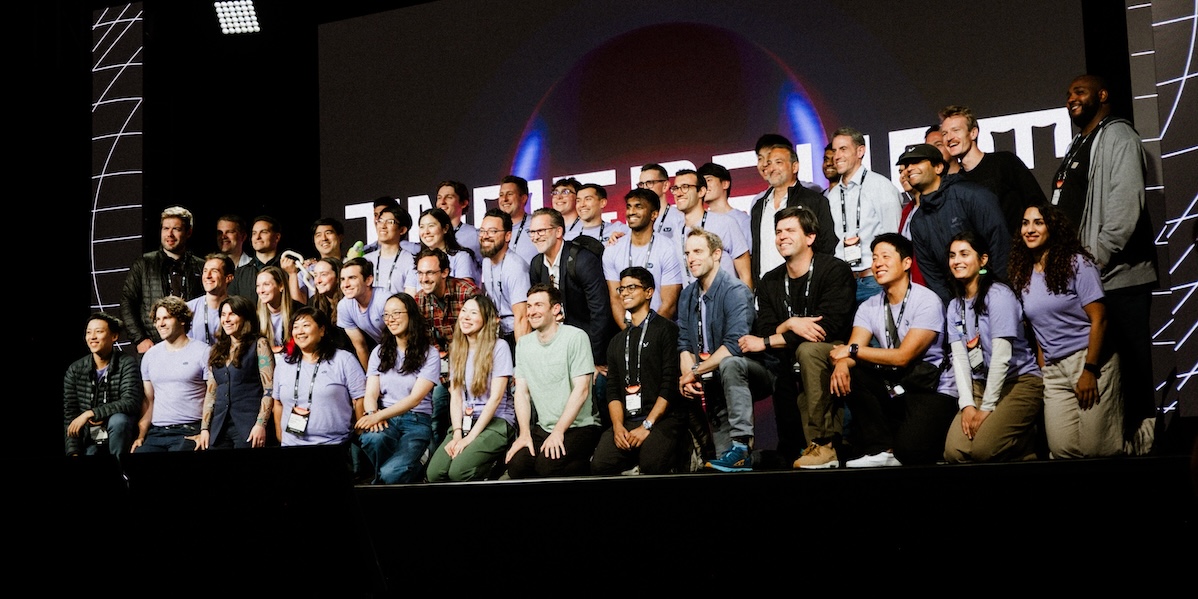While gold was taking a hit on Tuesday, the metals trade has outshined artificial intelligence on Wall Street this year, even the latter has propelled the broader stock market to record levels. Gold crossed the $4,000-per-ounce threshold earlier in October, and just this week, it hit a record above $4,300 . It’s currently up more than 50% this year. Not only that, silver is trading near record levels and has soared more than 60%. That’s despite easing trade tensions between the U.S. and China leading to a slight pullback in both metals – President Donald Trump said Monday he expects to reach a “really fair and really great” deal with Chinese President Xi Jinping in South Korea later this month. Precious metals have gained in 2025 thanks to concerns around global trade, expectations of Federal Reserve rate cuts and a drop in the U.S. dollar. But the size of those returns is unusual for gold and silver, especially when the stock market is doing well. The Nasdaq-100 is up more than 19% this year, while the the S & P 500 has climbed more than 14%, with both hitting records this year as a result of the AI investing boom. The commodity has even beaten out AI giant Nvidia’s jump of more than 34%. “The market is somewhat changing its view on gold as an asset class right now,” David Wagner, head of equity at Aptus Capital Advisors, said in an interview with CNBC. “It’s no longer just being utilized as kind of a simplistic way to hedge your currency or hedge your portfolio.” @GC.1 YTD mountain Gold futures, year-to-date Instead, investors are seeing it as a scarce asset as the ” currency debasement” trade gains momentum on Wall Street. This trade refers to investors hedging against government borrowing and money printing, lessening the U.S. dollar’s value by moving into gold and other assets. “People want to own risk assets,” Wagner said. “People want to own hard assets, given where we stand in our current debt and the debasement of currency that does occur on an annualized basis from inflation.” “The gold mentality has somewhat changed over the last few years,” he added. The run-up While gold has outpaced the broader market since the tech bubble peak in 2000, its move really became apparent in 2022, when the U.S. alongside others such as the European Union froze Russia’s central bank reserves in the wake of that country’s invasion of Ukraine . “That event woke up the rest of the world to say, ‘Hey, let me double check how much of U.S. dollar reserves I have, and maybe this is a good catalyst to reduce that exposure,’” said Peter Boockvar, chief investment officer at One Point BFG Wealth Partners. The move set off significant amounts of central bank gold buying in not only 2022 but also 2023 and 2024. That pace has since only quickened this year following Trump’s decision to impose “reciprocal” tariffs on a number of countries months ago. .DXY YTD mountain ICE U.S. dollar index, year-to-date The U.S. dollar , which has weakened in 2025, faced some pressure especially in response to the heightened uncertainty around Trump’s tariff plans. Those spurred foreign buyers to diversify away from the currency and turn to gold as an attractive alternative. Per data from Deutsche Bank, gold as a percentage of global reserve assets hit 24% in this year’s second quarter, the highest level since the mid- to late-1990s. “[In] the last couple months, all those retail and institutional investors that were selling in ’22, ’23 and ’24, now they’re seeing the price rise and [are] like, ‘Hey, let me get back in,’” Boockvar added. “We’re seeing that with the increase in ETF holdings of gold, so they’ve sort of piled on to what has already been a rally.” What’s next? Boockvar thinks that gold and other metals like silver are “probably due for a rest” in the short term after their massive gains this year. Although he still views the trade as a buy, he cautioned investors to be ready to purchase more on a pullback. Spot gold and spot silver were already running out of steam on Tuesday, sliding more than 5% and more than 8%, respectively. “We got way too extended, particularly relative to moving averages,” he said. “I’m still bullish, still very long, but I acknowledge that it’s probably ready for a digestion phase. Maybe the same for the stock market too.” Compared to AI, Baird investment strategist Ross Mayfield thinks gold’s outlook doesn’t necessarily stack up, saying that he’s “more inclined to kind of bet on the AI trade having more legs” due to a number of growth drivers, namely the narrative around AI, the earnings potential of AI-related companies, the technology’s use cases and the speed with which AI models are improving. “Not that the gold trade can’t continue to run, but gold is kind of a … known factor,” he remarked. “There are times where it does really well, but people know what gold is [and] traditionally what the narrative behind a gold story is, whereas AI still has this kind of like untapped upside.” There are others on Wall Street who are more bullish on gold from here. Louis Navellier of Navellier & Associates is one of them. He mentioned a lack of confidence in central banks and governments around the world, such as in France , as a reason for its latest advance. “A global interest rate collapse is unfolding, so central banks will have to continue to cut as deflation fears spread,” the firm’s founder and chief investment officer said. “Although the U.S. is an oasis from much of the world’s problems, gold is the best oasis amidst the chaos, so I expect gold to continue to rally.”
Blog
-

Genetic inflammatory signature defines depression subtypes and treatment response
Researchers led by Prof. Alessandro Serretti at Kore University of Enna have identified a genetic inflammatory signature that defines specific depression subtypes and influences how patients respond to antidepressant medications,…
Continue Reading
-

The maps of Ursula K Le Guin reveal a fascinating insight into world-building in fantasy fiction
One of the most prolific science-fiction writers of the last century, Ursula K. Le Guin was revered for her inventive, genre-defying novels. Exploring humanity through philosophy, gender, race and society, her stories were rooted in fantasy…
Continue Reading
-

Top Creators’ Shows Find Second Life Off YouTube
Creators are taking over yet another screen.
Free ad-supported services such as Tubi and Roku have been striking partnerships with top creators including MrBeast, Steven He and Alan Chikin Chow to feature their videos on their platform….
Continue Reading
-

More Europeans are dying from HIV now than 15 years ago
Europe, taken as a whole, is losing some of the gains it has made in tackling the burden of HIV, the 20thEuropean AIDS Conference (EACS 2025) heard in Paris.
Teymur Noori of the European Centre for Disease Prevention and Control (ECDC) told…
Continue Reading
-

LangChain: From Agent 0-to-1 to Agentic Engineering
Congratulations to Harrison, Ankush, Julia and everyone at LangChain on today’s $125M Series B funding announcement. It’s been a delight working with this team since leading the Series A.
Beyond the funding, today marks the release of langchain 1.0, a major rite of passage for any open source company. Releasing 1.0 reflects the team’s conviction that LangChain, as currently built and packaged, is the right foundational architecture to become the scaffolding for agent engineering.
LangChain is one of the most popular open-source projects in AI with 90M monthly downloads, and is used by 35% of the Fortune 500. The company has quickly grown from an open source package to a full-fledged agent engineering platform, including a low-level agent orchestration and runtime called LangGraph that’s used by companies such as Uber, Klarna, LinkedIn and J.P. Morgan; and an observability and agent deployment platform called LangSmith used by Clay, Cloudflare, Replit, Vanta, Rippling, Mercor and more.
LangChain is one of the most used, debated and sometimes misunderstood projects and companies in AI. Below are some reflections on the evolution of LangChain to date and how I view the opportunity ahead.
Early Days
Harrison Chase’s superpower is simple: he sees the future of agents. He saw it before just about anybody, and has consistently pushed the frontier of agent engineering forward.
Harrison started LangChain as a nights-and-weekends side project back in 2022, right as ChatGPT was taking off. The original LangChain was a proof-of-concept of what language models were capable of becoming: connect them with tools, chain them together into a sequence of calls and business logic, and voila, model becomes agent.
Harrison’s vision struck a chord with developers, and the LangChain project quickly became one of the fastest adopted open source projects. By the time we led the Series A in early 2023, it had more than 2,000 open-source contributors and was being used by more than 50,000 LLM applications. After two years of exponential growth, it is now surpassed only by OpenAI in download volume.
September 2025 Download Metrics (PYPI) (in millions) Crucible Moment: LangGraph
As the ecosystem matures, LangChain has matured alongside it, constantly growing the core open source package while also adding in new capabilities.
Because the LLM ecosystem is evolving at such a rapid clip, maintaining the scaffolding to support a developer ecosystem of this size hasn’t always been easy. But Harrison has been resilient and unflappable, constantly listening hard to his challengers and evolving the package towards the future.
Sometime last year, it became increasingly clear that the abstraction level on which the OG LangChain was built was a convenient launching point for developers, but wasn’t sufficiently low-level enough to support all the granular control that developers were craving as the space matured.
Harrison made the hard decision to develop another framework in parallel: LangGraph allows developers to control every step of their custom agent with low-level orchestration, memory, and human-in-the-loop support, and manage long-running tasks with durable execution.
This was a tough but remarkably wise call. Today, LangGraph is the most popular low-level agent orchestration framework and runtime, used by companies including Uber, Klarna, LinkedIn and J.P. Morgan and downloaded 12M times a month.
Getting one open-source project to broad product-market fit could be a function of luck. Getting two open-source projects to PMF is a testament to how clearly Harrison and the broader LangChain team see the future of agent development.
LangChain 1.0
Today marks a new chapter, merging LangChain’s past and future: the team has completely rewritten langchain in its 1.0 release to be opinionated, focused and powered by LangGraph’s runtime.
This means that langchain 1.0 has all the “0-to-1 booster fuel” the community has come to expect—pre-built architectures for common agent patterns, improved model and tool integrations, and more—but gives developers access to a deep level of customization and control.
In addition, helping developers on their agent engineering journey means expanding beyond frameworks into developer tools. Working with LLMs requires a mindset shift, from deterministic software to embracing stochasticity, constantly observing and testing data. To that end, the team has invested heavily in LangSmith, which enables agent engineering across the full lifecycle: observability, evaluation and deployment.
LangSmith has proven successful as a standalone developer platform for LangChain and non-LangChain developers alike, and is currently used by companies such as Clay, Cloudflare, Replit, Vanta, Rippling and Mercor, with traffic growing 12x year over year.
What’s Ahead
LangChain’s ambitions are large. This team will not stop until they become the de facto platform for all of agent engineering. They will get there by deepening their core offerings, and continuing to push the frontier.
Deepening the core: The team has pushed hard on deployment, making it possible to ship your agent in one click on LangSmith, using scalable infrastructure built for long-running tasks. They’ve also launched their first 1P agent, an Insights Agent in LangSmith Observability that automatically categorizes agent behavior patterns, as well as a no code text-to-agent builder experience for business users.
Pushing the frontier: As the model space progresses, the agentic building blocks also evolve. LangChain has been hard at work on many of the core primitives we believe will drive the future of agentic engineering, including memory.
It’s hard to believe LangChain is just three years old. We are proud to partner with a team that has adapted so resiliently, and more important, driven so much innovation in the agent engineering ecosystem. Today’s milestone is just the beginning.
Continue Reading
-

‘Samo Lives’ Cast Adds 14
Samo Lives, the Jean-Michel Basquiat biopic produced and financed by Fifth Season and Macro Film Studios, which stars Kelvin Harrison Jr. as the iconic artist, has wrapped production with 14 additions to the cast. They are Danny Ramirez (Top…
Continue Reading
-

Google Fi will start using AI to make calls sound better
Google for its digital telecom provider, Google Fi. It’s introducing AI-enhanced audio for better sound quality during calls. The company says this will ensure “optimized audio quality for every call, so you can confidently take calls from a…
Continue Reading
-
Retinal Implant-Eyeglasses Combination Improved Vision in Geographic Atrophy – MedPage Today
- Retinal Implant-Eyeglasses Combination Improved Vision in Geographic Atrophy MedPage Today
- Life-changing eye implant helps blind patients read again BBC
- Vision Restored Using Prosthetic Retinal Implant The New York Times
- Experts hail…
Continue Reading
-

Amandaland Christmas special confirmed as series 2 filming begins
The second series of the hit BBC comedy Amandaland, starring Lucy Punch, Joanna Lumley and Philippa Dunne, is coming to iPlayer and BBC One in 2026.
Alongside the returning cast, the Christmas special welcomes the absolutely fabulous Jennifer…
Continue Reading
